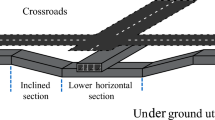Abstract
As the dimension of the slurry shield is greatly increasing, more and more attention is paid to the face stability of slurry shield-driven tunnel in recently years. A reduced-scale slurry shield model test is carried out based on the background of Qianjiang River Tunnel and Shanghai Yangtze River Tunnel. The results of the model test are presented in this paper with particular emphasis on the slurry shield driving parameters and the critical slurry pressure of the excavating face. It is shown that the behavior of large slurry shield-driving induced by the cutting face is mostly decided by the fluctuation of the slurry pressure in the chamber, and a smaller slurry pressure fluctuation range is presented according to the results of the physical model test. Especially, it is more difficult to control the machine in sandy silt than that in soft clay and muddy clay. The chamber pressure will fluctuate greatly when excavating in high permeability ground, and the gradient of accumulation of the flux difference could be used to evaluate the face balance of the slurry shield excavation.
Similar content being viewed by others
References
Zhang Z X, Hu X Y, Scott K D. A discrete numerical approach for modelling face stability in slurry shield tunnelling in soft soils [J]. Computers and Geotechnics, 2011, 38: 94–104.
Hu Xin-yu, Zhang Zi-xin. Analysis of effect of slurry infiltration on shear strength of soil of excavation face in slurry shield under general stress condition [J]. Journal of Rock Mechanics and Engineering, 2009, 28(5): 1027–1036 (in Chinese).
Li Y, Emeriault F, Kastner R, et al. Stability analysis of large slurry shield-driven tunnel in soft clay [J]. Tunnelling and Underground Space Technology, 2009, 24: 472–481.
Broere W. Tunnel face stability and new CPT applications [D]. Delft: Delft University of Technology, 2001.
Anagnostou G, Kovari K. The face stability of slurry shield-driven tunnels [J]. Tunnelling and Underground Space Technology, 1994, 9(2): 165–174.
Leca E, Domnieux L. Upper and lower bound solutions for the face stability of shallow tunnels in frictional material [J]. Géotechnique, 1990, 40(4): 581–606.
Kisch A. Experimental investigation of face stability of shallow tunnels in sand [J]. Acta Geotechnics, 2010, 5: 43–62.
Sloan S W, Assadi A. Undrained stability of a square tunnel in a soil whose strength increases linearly with depth [J]. Computer Geotechnics, 1991, 12(4): 321–46.
Chambon P, Corte J F. Shallow tunnels in cohesionless soil: Stability of tunnel face [J]. Journal of Geotechnical Engineering, 1994, 120(7): 1148–1165.
Broms B B, Bennermark H. Stability of clay at vertical openings [J]. Journal of the Soil Mechanics and Foundations Division, 1967, 93(1): 71–94.
Takano D, Otani J, Nagatani H, et al. Application of X-ray CT on boundary value problems in geotechnical engineering — research on tunnel face failure [C]//Proceedings of Geocongress of ASCE. Atlanta: ASCE, 2006: 1–6.
Mollon G, Dias D, Soubra A-H. Rotational failure mechanisms for the face stability analysis of tunnels driven by a pressurized shield [J]. International Journal for Numerical and Analytical Methods in Geomechanics, 2011, 35(12): 1363–1388.
Broere W. Face stability calculation for a slurry shield in heterogeneous soft soils [J]. Tunnels and Metropolises, 1998, 23: 215–218.
Davis E H, Gunn M J, Mair R J, et al. The stability of shallow tunnels and underground openings in cohensive material [J]. Géotechnique, 1980, 30(4): 397–416.
Nishioka I, Kawase O, Namikawa K, et al. Excavation of Japan’s largest shield tunnels in the heart of Tokyo Metropolitan area-the Nishi-Shinjuku Tunnel [J]. Tunnelling and Underground Space Technology, 2004, 19: 346–358.
Mair R. Centrifugal modeling of tunnel construction in soft clay [M]. London: Cambridge University Press, 1979.
Yoo C, Shin H K. Deformation behavior of tunnel face reinforced with longitudinal pipes — laboratory and numerical investigation [J]. Tunnelling and Underground Space Technology, 2003, 18: 303–319.
Kamata H, Mashimo H. Centrifuge model test of tunnel face reinforcement by bolting [J]. Tunnelling and Underground Space Technology, 2003, 18: 205–212.
Author information
Authors and Affiliations
Corresponding author
Additional information
Foundation item: the National Natural Science Foundation of China (No. 51108268), the Program for Changjiang Scholars and Innovative Research Team in University (PCSIRT, IRT1029), and the Key Technology Research on Qianjiang Tunnel Project (No. 2009-35333340)
Rights and permissions
About this article
Cite this article
Hu, Xy., Zhang, Zx. Physical model test on the behavior of large slurry shield-driving tunnel in soft clay. J. Shanghai Jiaotong Univ. (Sci.) 18, 693–698 (2013). https://doi.org/10.1007/s12204-013-1451-9
Received:
Published:
Issue Date:
DOI: https://doi.org/10.1007/s12204-013-1451-9




